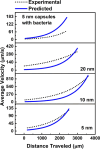Predictive Modeling and Experimental Validation of Magnetophoretic Delivery of Magnetic Nanocultures
- PMID: 40641610
- PMCID: PMC12239069
- DOI: 10.1021/acsmaterialslett.5c00753
Predictive Modeling and Experimental Validation of Magnetophoretic Delivery of Magnetic Nanocultures
Abstract
Magnetophoresis offers a powerful strategy for the targeted delivery of functional microcapsules. Here, we present a combined theoretical and experimental framework to predict the magnetophoretic transport of magnetic nanocultures-microcapsules embedded with magnetic nanoparticles and living cells. We derive a novel analytical expression for the terminal velocity of microcapsules under a spatially decaying magnetic field. The model incorporates magnetic and hydrodynamic forces in low Reynolds number regimes and predicts microcapsule velocity variations with nanoparticle size and field strength. Experimental validation using nanocultures containing nanoparticles 5, 10, and 20 nm in size confirms the model's accuracy, with 10-nm particles showing optimal magnetophoretic response. The model also accounts for hindered motion at high microcapsule densities. This work provides a predictive tool for designing magnetically guided systems for microbial delivery, localization, and patterning, with applications in bioreactors, therapy, and engineered living materials.
© 2025 The Authors. Published by American Chemical Society.
Figures





Similar articles
-
Magnetophoresis of weakly magnetic nanoparticle suspension around a wire.J Chem Phys. 2025 Jul 14;163(2):024903. doi: 10.1063/5.0269000. J Chem Phys. 2025. PMID: 40631836
-
Magnetically Responsive Nanocultures for Direct Microbial Assessment in Soil Environments.bioRxiv [Preprint]. 2025 May 18:2025.05.17.654660. doi: 10.1101/2025.05.17.654660. bioRxiv. 2025. PMID: 40463148 Free PMC article. Preprint.
-
Cost-effectiveness of using prognostic information to select women with breast cancer for adjuvant systemic therapy.Health Technol Assess. 2006 Sep;10(34):iii-iv, ix-xi, 1-204. doi: 10.3310/hta10340. Health Technol Assess. 2006. PMID: 16959170
-
Are Current Survival Prediction Tools Useful When Treating Subsequent Skeletal-related Events From Bone Metastases?Clin Orthop Relat Res. 2024 Sep 1;482(9):1710-1721. doi: 10.1097/CORR.0000000000003030. Epub 2024 Mar 22. Clin Orthop Relat Res. 2024. PMID: 38517402 Free PMC article.
-
Localization techniques for guided surgical excision of non-palpable breast lesions.Cochrane Database Syst Rev. 2015 Dec 31;2015(12):CD009206. doi: 10.1002/14651858.CD009206.pub2. Cochrane Database Syst Rev. 2015. PMID: 26718728 Free PMC article.
References
-
- Niepa, T. H. R. ; Davidson, S.-L. . Microcapsules and methods of using the same. US Patent 11,534,408, 2025.
-
- Usman H., Molaei M., House S., Haase M. F., Dennis C. L., Niepa T. H.. Magnetically Responsive Nanocultures for Direct Microbial Assessment in Soil Environments. bioRxiv. 2025:2025.05.17.654660. doi: 10.1101/2025.05.17.654660. - DOI
-
- Edwards, M. ; Hewlin Jr, R. L. . A Computational Model for Analyisis of Field Force and Particle Dynamics in a Ferro-Magnetic Microfluidic System. In ASME International Mechanical Engineering Congress and Exposition; American Society of Mechanical Engineers, 2022; Vol. 86663, p V004T005A007.
Grants and funding
LinkOut - more resources
Full Text Sources
